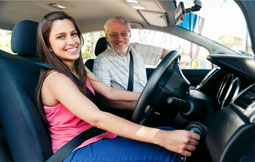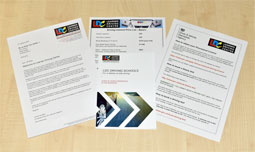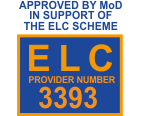Driving lesson 12. Dual carriageways
Introduction
The term dual carriageway refers to a road where there is a physical separation between streams of traffic travelling in opposite directions. The barrier is usually a grass verge in the centre of the road with or without a crash barrier.
Key learning notes
 Dual carriageways
Dual carriageways
Each side of the dual carriageway can have a number of lanes (typically two or three). Keep to the left-hand lane unless signs or road markings indicate otherwise or unless you are overtaking. On dual carriageways traffic can travel up to 70mph, the key to dealing with this traffic is good forward observations to assess the traffic situation ahead and the effective use of mirrors to assess the traffic situation behind.
 End of dual carriageway
End of dual carriageway
Watch out for the 'end of dual carriageway' sign. Don't start to overtake after you see the sign, otherwise you might run out of road or worse, find yourself facing oncoming traffic head on.

 Clearways
Clearways
Clearways are not restricted to dual carriageways. However, most dual carriageways are clearways. On roads with the clearway sign you must not stop on the main carriageway except in a layby. Clearways are designed to allow the free flow of traffic.
Junctions and slip roads
All the usual junction types can be found on dual carriageways including traffic light controlled. On dual carriageways cars are allowed to travel at speeds up to 70 mph so it can be quite difficult to judge a suitable gap in the traffic when emerging ahead, to the left or to the right. To help reduce the dangers slip roads were developed. A slip road is the term commonly used to describe an acceleration or deceleration lane that helps to maintain the flow of traffic on the dual carriageway by providing a much safer way to join and leave fast flowing traffic. It is the only method allowed on motorways.
Using slip roads
A slip road can be used to build up your speed so that you can time your entry on to the carriageway to coincide with a suitable gap in the traffic from your right. The objective is to match the speed of the traffic on the carriageway so the gap needed will be minimal. If you are travelling at a slower speed then the gap needed will have to be much larger. Unfortunately slip roads come in varying lengths therefore it is not always possible to match the speed of the traffic you intend to merge with. Consequently, even before you commence the manoeuvre of joining a carriageway you must assess the length of the slip road to determine what speed you can attain and what gaps there are in the traffic from your right. Once you can see a reasonably sized gap coming towards you in the mirrors adjust your speed so that you can merge safely at the same time as the gap appears to your right.
You then need to check your mirrors again and possibly glance over your right shoulder just before joining the carriageway. Therefore to complete this manoeuvre you effectively use the hazard drill at least twice with extra observations through the mirrors.
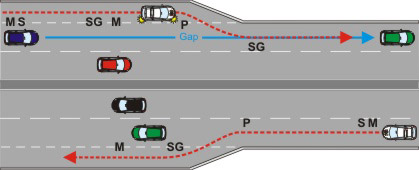
Short slip roads
As mentioned earlier some slip roads are quite short and therefore the gap in the traffic that you need to merge in
safely needs to be much bigger. In the example below you should wait at the start of the slip road if the carriageway is particularly busy. This will allow you to build your speed up when a suitable gap appears.
When a slip road is available to leave a dual carriageway you should try to avoid reducing your speed until you have entered the slip road. If the slip road is too short to allow you to do this then you should start to reduce speed before you enter the slip road. In which case you effectively use your hazard drill twice, once to reduce speed just prior to entering the slip road and once just as you begin to enter the slip road.
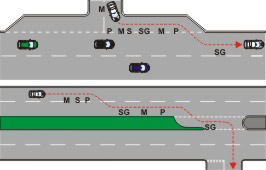
Overtaking
When you overtake on a dual carriageway you would use your hazard drill at least three times. Once to get ready to overtake, once to actually overtake and once to move back into the left hand lane.
 P - move into the left hand lane without cutting in.
P - move into the left hand lane without cutting in.
S - cancel your signal.
M - check your mirrors to see what is following and ensure it is safe to move back into the left hand lane.
S & G - Speed up, especially if you had to reduce speed earlier.
P - Move your vehicle into the right hand lane while maintaining adequate clearance from the target vehicle.
S - Signal your intention to overtake.
M - Check your mirrors and glance to your right to ensure it is safe to continue with the overtake.
S & G - Adjust your speed to match that of the vehicle in front if it is not safe to proceed with the overtake or select the best gear for overtaking.
P - Maintain a safe distance behind the vehicle in front.
M - Check your mirrors well in advance for potential gaps behind.
Highway Code study
Rules: 106 - 108, 116, 130 - 139, 173, 288 - 290.

